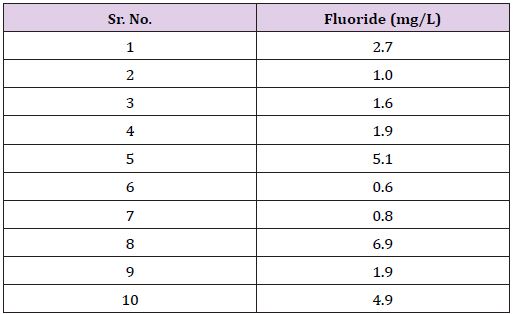Impact Factor : 0.548
- NLM ID: 101723284
- OCoLC: 999826537
- LCCN: 2017202541
Rajesh Kumar1*, Neerja Kalra2 and SS Yadav 3
Received:September 24, 2017; Published:October 06, 2017
Corresponding author:Rajesh Kumar, Assistant Professor in Chemistry, RPS (P.G) College Balana, Mahendergarh, India
DOI: 10.26717/BJSTR.2017.01.000420
Water, the precious gift to nature of human being is going to be polluted day by day with in increasing urbanization. Although three fourth part of earth is being surrounded by water but a little portion of it can be used for drinking purpose. In India around 62.5million people are suffering from disorder of teeth or bones through fluorosis [1]. Seventeen states in India have been identified as endemic for fluorosis & Haryana is one of them. Although fluoride enters through food, water, industrial exposure, drugs, cosmetics etc. Drinking water is the major contributor (70-90% of daily intake) [2]. Due to its strong electro negativity; fluoride is attracted by positively charged calcium in teeth and bones. The major1health problem is caused by fluoride are dental fluorosis, teeth mottling, Skelton fluorosis and deformation of bones in children as well as adults [3]. According to WHO [4], permissible limits for fluoride in drinking water is 1.0mg /l [4] where as USPHS [5]. The maximum allowable concentration for fluoride in drinking water in Indian condition comes to 1.0 mg/l while as per Indian standards it is 1.5mg/l [6-8]. The routine monitoring of water can assure the populace that the quality of their drinking water is adequate. It can also be beneficial in detecting deterioration in the quality of drinking water and facilitate appropriate timely corrective actions with minimal negative impacts on population health.
Table 1:Fluoride Content in Ground water of Mahendergarh District.

Water Sampling: A total of 10 ground water samples taken from ten locations of Mahendergarh district were collected in polythene bottles which were cleaned with acid water, followed by rinsing twice with distilled water. The water samples are chemically analyzed. The analysis of water was done using procedure of standard methods.
Study Area: Mahendergarh district, which is one of the 21 districts of Haryana state in northern India. The district occupies an area of1, 859 km2.The district has a population of 812,022(2001 census). Narnaul Town is the administrative headquarters of the district. Mahendergarh is one of the very few districts in India where the name of the district and its town are different. As of 2011 it is the third least populous district of Haryana (out of 21), after panchkula and Rewari. The district lies between north Study Area: Mahendergarh district, which is one of the 21 districts of Haryana state in northern India. The district occupies an area of1, 859 km2.The district has a population of 812,022(2001 census). Narnaul Town is the administrative headquarters of the district. Mahendergarh is one of the very few districts in India where the name of the district and its town are different. As of 2011 it is the third least populous district of Haryana (out of 21), after panchkula and Rewari. The district lies between north latitude 270 to 280 26 and east longitude 750 56’ to 760’51’.
Methodology: F-Spectophotometrically using ELICO-52 UV Spectrophotometer [9].
Most of the water sample, collected from the different location in Mahendergarh do not meets the water quality standards and many other quality parameters. Hence it is not suitable for consumption with any prior treatment.


